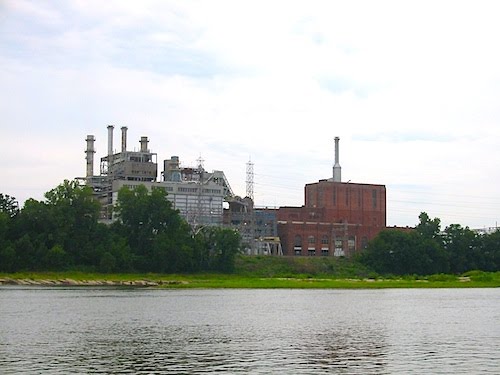Where does our electricity come from?
The Kaw helps to produce electricity from coal-fired power plants, natural gas plants, and hydropower dams.
Producing electricity requires water, lots of water. That’s why electrical generating plants in Kansas are located along rivers. The Westar Energy Centers (Jeffrey, Tecumseh and Lawrence) draw water from the river to produce steam to turn their turbines, while the hydroelectric facility at Bowersock Mills and Power Company depends on the water flowing down the Kaw to directly turn its turbines. The Board of Public Utilities plant in Wyandotte County has had to put its power plant in long-term cold storage because the drought in the 1990’s combined with the lowering of the Kansas River due to river bed degradation left it without enough water to cover its intakes. Without water we can’t produce electricity from coal, natural gas, or hydroelectric facilities.
View River Inventory Energy in a larger map
Jeffrey Energy Center-Westar
View River Inventory Energy in a larger map
The Jeffrey Energy Center relies on coal to produce electricity. According to Brad Loveless, the Director of Biology and Conservation Programs at Westar, the coal used by Jeffrey comes from Eagle Butte Mine, which is owned by Alpha Natural Reources, Southern Powder Basin, Gillette, Wyoming (see map below). Jeffrey has the capacity to produce 1,857 megawatts of electrical power annually. During a year Jeffrey Energy Center uses 9,153,000 tons of coal, 9,700 bbls* of oil, and withdraws 4,618,620,000 gallons of water.
* one barrel of oil (bbls)=42 gallons of oil
Eagle Butte Coal Mine in Wyoming
View River Inventory Energy in a larger map
Tecumseh Energy Center-Westar
View River Inventory Energy in a larger map
 The Tecumseh Energy Center uses a combination of coal (768,000 tons annually) and natural gas (115,000,000 cubic feet of gas annually), and withdraws 992,912,000 gallons of water to produce energy. Tecumseh has a much smaller capacity for production than Jeffreys (242 MW annually). The coal used by both the Tecumseh Energy Center and the Lawrence Energy Center comes from Black Thunder Mine, owned by Arch Coal Inc. in Gillette, Wyoming. The natural gas comes from co-mingled, multi-source gas from Oklahoma, Texas, Kansas and Colorado. (Our thanks to Brad Loveless for this information.)
The Tecumseh Energy Center uses a combination of coal (768,000 tons annually) and natural gas (115,000,000 cubic feet of gas annually), and withdraws 992,912,000 gallons of water to produce energy. Tecumseh has a much smaller capacity for production than Jeffreys (242 MW annually). The coal used by both the Tecumseh Energy Center and the Lawrence Energy Center comes from Black Thunder Mine, owned by Arch Coal Inc. in Gillette, Wyoming. The natural gas comes from co-mingled, multi-source gas from Oklahoma, Texas, Kansas and Colorado. (Our thanks to Brad Loveless for this information.)
Below is a satellite image of the Black Thunder Mine from Google Maps.
Black Thunder Mine in Wyoming
View River Inventory Energy in a larger map
Lawrence Energy Center-Westar
View River Inventory Energy in a larger map
The Lawrence Energy Center has a capacity to produce 539 MW of electricity annually. It uses 2,029,000 tons of coal, 124,000,000 cubic feet natural gas and 1,582,033,000 gallons of water per year. The suppliers of coal and gas are the same as those for the Tecumseh Energy Center. (Thanks to Brad Loveless for this information)
Bowersock Hydroelectric Dam
View River Inventory Energy in a larger map
According to Bowersock Mills and Power Company, “Low-head (<30 meters) development or Run-of-river plants tap the energy in streams and rivers. These plants sometimes use small reservoirs retaining up to a week’s water supply, but low speed turbines are used which are designed to handle large volumes of water at low pressure, so often, no reservoir is needed. Run-of-river plants are small units and subject to large fluctuations in output due to variable rainfall. Bowersock is a 2.5 MW run-of-the-river facility on the Kaw (Kansas) River in Lawrence.”
Board of Public Utilities
View River Inventory Energy in a larger map
The BPU has a power station in Kansas City Kansas that is on the Kansas River. It operates on both coal and natural gas. Its current status is ‘Long Term Cold Storage’. We ceased operation on coal about 1997, then later ran it for about 5 years on natural gas for summer load only. The Kansas River conditions were a major factor in our discontinuing its use and placing it into long term cold storage. More specifically, the combination of drought conditions and river bed degradation lowered the river elevation at the intake to a point were we could not draw adequate cooling water from the river. There are no immediate plans to return it to service at this time.
Darrell Dorsey, P.E.
Manager of Electric Production and Supply
Board of Public Utilities

